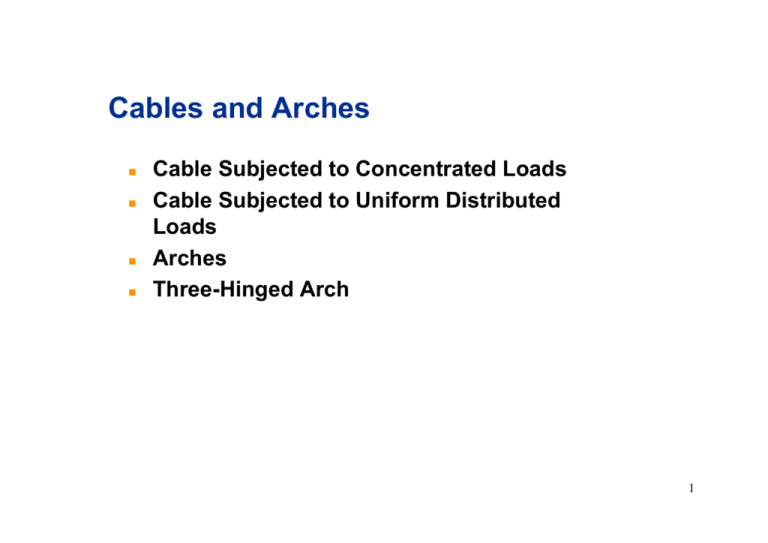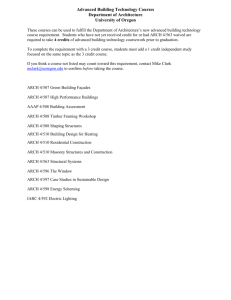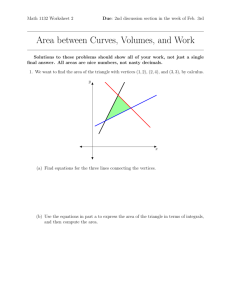Document
advertisement

Cables and Arches ! ! ! ! Cable Subjected to Concentrated Loads Cable Subjected to Uniform Distributed Loads Arches Three-Hinged Arch 1 Cable Subjected to Concentrated Loads A Ay Ax θ θ D yC yD B L2 C P1 P2 L1 yD B C P1 D yC L3 P2 L1 L TCD L2 L3 L + Σ MA = 0: Obtain TCD y y TBA TCD TCB C B x P2 + ΣF = 0: x + ΣFy = 0: x TBC P1 2 Example 5-1 Determine the tension in each segment of the cable shown in the figure below. Also, what is the dimension h ? A h D B 2m C 3 kN 2m 2m 8 kN 2m 1.5 m 3 Ay SOLUTION Ax A TCD D5 4 3 h B 2m C 3 kN 2m 8 kN 2m 1.5 m + ΣMA = 0: TCD(3/5)(2 m) + TCD(4/5)(5.5 m) - 3kN(2 m) - 8 kN(4 m) = 0 TCD = 6.79 kN 4 y Joint C TCD = 6.79 kN C 5 4 θBC 3 8 kN TCB x + ΣF = 0: 6.79(3/5) - T cos θ x CB BC + TCB = 4.82 kN Joint B TBA + ΣF = 0: - T cos θ + 4.82 cos 32.3o = 0 BA BA x B 32.3o θBA ΣFy = 0: 6.79(4/5) - 8 + TCB sin θCB = 0 θBC = 32.3o y =0 x TBC = 4.82 kN + ΣFy = 0: TBA sin θBA - 4.82 sin 32.3o - 3 = 0 3 kN θBA = 53.8o A h TBA = 6.90 kN D B 3 kN C 8 kN h = 2 tanθBA = 2 tan53.8o = 2.74 m 5 Cable Subjected to Distributed Load Concepts & Conclusion: T y θ T θ To x W x=L W To T cos θ = To = FH = Constant T sin θ = W dy W = tan θ = dx To 6 Parabolic Cable: Subjected to Linear Uniform distributed Load T wo = force / horizontal distance θx y To B A x L x y wox wo x x 2 wo x dx To 2 0 wo x + C1 2To wo x 2 To = 2y T x x y=∫ y= θx To dy wx = tan θ = o dx To at x = L , T = TB = Tmax 2 Tmax = To + ( wo L) 2 Tmax woL θΒ To 7 Derivation: wo(∆x) y ∆x 2 T + ∆T wo O h x x θ T ∆s ∆x θ+ ∆θ ∆y ∆x L + ΣF = 0: x -T cosθ + (T + ∆T) cos (θ + ∆θ) = 0 ΣFy = 0: -Tsinθ + wo(∆x) + (T + ∆T) sin(θ + ∆θ) = 0 + ΣMO = 0: wo(∆x)(∆x/2) - T cos θ(∆y) - T sinθ(∆x) = 0 + 8 Dividing each of these equations by ∆x and taking the limit as ∆x ∆y 0, ∆θ 0, and ∆T 0, we obtain T θ To wox d (T cos θ ) =0 dx ----------(5-1) d (T sin θ ) = wo dx ----------(5-2) dy = tan θ dx ----------(5-3) 0, and hence Integrating Eq. 5-1, where T = FH at x = 0, we have: T cosθ = FH ----------(5-4) Integrating Eq. 5-2, where T sin θ = 0 at x = 0, gives T sin θ = wo x ----------(5-5) Dividing Eq. 5-5 by Eq. 5-4 eliminates T. Then using Eq. 5-3, we can obtain the slope at any point, tan θ = dy wo x = dx FH ----------(5-6) 9 Performing a second integration with y = 0 at x = 0 yields y= wo 2 x 2 FH ----------(5-7) y This is the equation of a parabola. The constant FH may be obtained by using the boundary condition y = h at x = L. Thus, wo L2 FH = ----------(5-8) 2h h 2 x L2 h x L Finally, substituting into Eq. 5-7 yeilds y= wo ----------(5-9) From Eq. 5-4, the maximum tension in the cable occurs when θ is maximum; i.e., at x = L. Hence, from Eqs. 5-4 and 5-5, Tmax = FH 2 + ( wo L) 2 ----------(5-10) Tmax woL θΒ To 10 Example 5-2 The cable shown supports a girder which weighs 12kN/m. Determine the tension in the cable at points A, B, and C. 30 m A C 12 m B 6m 11 SOLUTION TA θA 30 m A y TC C 12 m 6m B 30 - L´ x2 θC x wo = 12 kN/m L´ x1 12 y TC θC C To 6m B x wo = 12 kN/m 12 L´ L´ 12 x1 dy1 = tan θ = dx1 To y1 = ∫ 12 x1 dx1 To 0 12 x y1 = + C1 2To 2 1 12 L'2 6= 2To x1 To = L'2 Tx1 ----------(1) 12x1 θ To 13 TA θA y A 12 x2 dy2 = tan θ = dx2 To 12 m B To wo = 12 kN/m 12 (30 - L´) 30 - L´ x2 x 0 12 x2 12 x22 y2 = ∫ dx2 = + C2 To 2To 12 x2 y2= 2To 2 12(30 − L' ) 2 12 = 2To (30 − L' ) 2 1= 2To ----------(2) Tx2 12 x2 θ To 14 To = L'2 ----------(1) (30 − L' ) 2 1= 2To From (1) and (2), ----------(2) L´ = 12.43 m, To = 154.5 kN TB = To = 154.5 kN TC 12 L´ TA 12 (30 - L´ ) θA θC To To 2 TC = To + (12 L' ) 2 = (154.50) 2 + (12 ×12.43) 2 = 214.8 kN 2 TA = To + [12(30 − L' )]2 = (154.50) 2 + [12(30 − 12.43)]2 = 261.4 kN 15 Example 5-3 The suspension bridge in the figure below is constructed using the two stiffening trusses that are pin connected at their ends C and supported by a pin at A and a rocker at B. Determine the maximum tension in the cable IH. The cable has a parabolic shape and the bridge is subjected to the single load of 50 kN. I H 8m D A Pin E B F G 4 @ 3 m = 12 m C 6m rocker 50 kN 4 @ 3 m = 12 m 16 SOLUTION Hy Iy To 8m H I 8m D A F Ay To E 6m Ax To G 12 m To 6m C Cx Cy + ΣMA = 0: Cx C Cy 50 kN 3m B By 9m + ΣMB = 0: − 12C y + 50(9) − 8To = 0 − 12C y + 8To = 0 To = 1.5C y ----------(1) From (1) and (2), Cy = 18.75 kN, To = −1.5C y +56.25 To = 28.125 kN ----------(2) 17 From (1) and (2), TI y θI Cy = 18.75 kN, I 8m To = 28.12 kN Tx wox To = 28.12 kN x wo wox 12 m θ 28.12 kN dy wx = tan θ = o dx 28.12 y=∫ x y= wo x dx 28.12 2 wo x + C1 28.12 0 wo (12) 2 8= 2(28.12) wo = 3.125 kN/m 18 TH TI θΙ H I 8m 8m To = 28.12 kN To = 28.12 kN 12wo = 37.5 kN 12wo = 37.5 kN 12 m 37.5 kN θH 12 m TI θI TI = (37.5) 2 + ( 28.12) 2 = 46.88 kN 28.12 kN Tmax = TI = TH = 46.88 kN Tmin= To = 28.12 kN 19 T D 0 Ax T A F T T T T T = wo × 3 = 3.125 × 3 = 9.375 kN E G Ay 4 @ 3 m = 12 m + ΣMA = 0: T C 50 kN B By 4 @ 3 m = 12 m 9.375(3 + 6 + 9 + 12 + 15 + 18 + 21) − 50(15) + B y ( 24) = 0 By = -1.56 kN, + ΣFy = 0: A y +7(9.375) − 50 − 1.56 = 0 Ay = -14.07 kN, 20 Example 5-4 For the structure shown: (a) Determine the maximum tension of the cable (b) Draw quantitative shear & bending-moment diagrams of the beam. E 0.5 m D 8m 1 kN/m 8m A B 5m C Hinge 20 m 21 Ey SOLUTION 0.5 m To 8m 20 kN Dy 5 kN D To Ax A Ay B 1 kN/m Bx By 5m To E 8m To 1 kN/m Bx B C By Cy 20 m + ΣMA = 0: + ΣMC = 0: B y (5) − 5( 2.5) + To (0.5) = 0 B y (20) + 20(10) − To (8) = 0 From (1) and (2), By = 0, To = 25 kN 22 y Tx wox θ To= 25 kN TE = Tmax E θ 8m x To= 25 kN 20wo 20 m TE = Tmax θ To= 25 kN dy wx = tan θ = o dx 25 wx y = ∫ o dx 25 0 wo x 2 = + C1 2(25) wo (20) 2 8= 2(25) wo = 1 kN/m 20wo = 20 kN Tmax = TE = ( 25) 2 + ( 20) 2 Tmax = 32.02 kN 23 T = wo(2.5 m) = (1kN/m)(2.5 m) = 2.5 kN 2.5 2.5 2.5 2.5 2.5 2.5 2.5 2.5 2.5 1 kN/m Ax C B A Cy = 1.25 kN Ay =1.25 kN 5m 20 m 10 @ 2.5 m = 25 m V (kN) 1.25 1.25 1.25 1.25 1.25 x (m) -1.25 -1.25 -1.25 -1.25 -1.25 M (kN•m) 0.78 0.78 0.78 0.78 0.78 0.78 0.78 0.78 0.78 0.78 x (m) 24 Example 5-5 The cable AB is subjected to a uniform loading of 200 N/m. If the weight of the cable is neglected and the slope angles at points A and B are 30o and 60o, respectively, determine the curve that defines the cable shape and the maximum tension developed in the cable. y B 60o A 30o x 200 N/m 15 m 25 SOLUTION TB B 60o 60o A TA 30o (0.2 kN)(15 m) = 3 kN 15 m 60o 30o 3 kN TB TB = 5.20 kN 120o 30o 30o TA TB 3 TA = = sin 120 o sin 30 o sin 30 o 30o TA = 3 kN 26 y 0.2x T θ TA = 3 kN A T θ x 30o 3 kN 30o 3 sin 30o = 1.5 3 cos 30o = 2.6 0.2x x 0.2 x + 1.5 dy = tan θ = 2.6 dx dy = 0.0769 x + 0.577 dx y = ∫ 0.0769 x + 0.577 y= 2 0 0.0769 x + 0.577 x + C1 2 y = 0.0385x2 + 0.577x 27 Example 5-6 The three-hinged open-spandrel arch bridge shown in the figure below has a parabolic shape and supports the uniform load . Show that the parabolic arch is subjected only to axial compression at an intermediate point D along its axis. Assume the load is uniformly transmitted to the arch ribs. y 7 kN/m x B D − 7.5 2 y= x (15) 2 A 15 m 7.5 m 7.5 m C 7.5 m 28 SOLUTION 210 kN B y= Ax Ay 15 m − 7.5 2 x (15) 2 15 m Cx Cy Entire arch : + ΣMA = 0: C y (30) − 210(15) = 0 Cy = 105 kN + ΣFy = 0: Ay − 210 + 105 = 0 Ay = 105 kN 29 105 kN B Bx By Cx B 7.5 m 7.5 m 105 kN Arch segment BC : + ΣMB = 0: − 105(7.5) + 105(15) − C x (7.5) = 0 Cx = 105 kN + ΣF = 0: x + ΣFy = 0: Bx = 105 kN B y − 105 + 105 = 0 By = 0 30 52.5 kN B 105 kN 0 MD D 26.6o ND VD 26.6o 3.75 m Arch segment BD : A section of the arch taken through point D, x = 7.5 m, y = -7.5(7.52)/(15)2 = -1.875 m, is shown in the figure. The slope of the segment at D is tan θ = dy − 15 = x = −0.5 , 2 dx (15) x =7.5 θ = 26.6o + ΣF = 0: x 105 - ND cos 26.6o - VD sin 26.6o = 0 + ΣFy = 0: -52.5 + ND sin 26.6o - VD cos 26.6o = 0 + ΣMD = 0: MD + 52.5(3.75) - 105(1.875) = 0 ND = 117.40 kN, VD = 0, MD = 0 kN 31 52.5 kN Alternate Method 105 kN B 0 MD D 26.6o ND VD 26.6o 3.75 m Arch segment BD : A section of the arch taken through point D, x = 7.5 m, y = -7.5(7.52)/(15)2 = -1.875 m, is shown in the figure. The slope of the segment at D is tan θ = dy − 15 = x 2 dx (15) 7.5 wo = (7.5)(7)= 52.5 kN Tmax = TE = (105) 2 + (52.5) 2 Tmax = 117.4 kN x = 7.5 = −0.5 , θ = 26.6o ND θ No= 25 kN Notes : Since the arch is a parabola, there are no shear and bending moment, only ND is present 32 Example 5-7 The three-hinged tied arch is subjected to the loading shown in the figure below. Determine the force in members CH and CB. The dashed member GF of the truss is intended to carry no force. 20 kN 15 kN 15 kN G H 1m C B 4m F D E A 3m 3m 3m 3m 33 20 kN SOLUTION 15 kN 15 kN G H 1m C B 4m Ax F D E A Ay Ey 3m + ΣMA = 0: 3m 3m 3m E y (12) − 15(3) − 20(6) − 15(9) = 0 Ey = 25 kN + ΣF = 0: x Ax = 0 + ΣFy = 0: Ay − 15 − 20 − 15 + 25 = 0 Ay = 25 kN 34 20 kN 15 kN G H B 5m 0 C 0 Cx Cy A FAE 25 kN 3m + ΣMC = 0: 3m FAE (5) − 25(6) + 15(3) = 0 FAE = 21.0 kN + ΣF = 0: x -Cx + 21= 0 Cx = 21.0 kN + ΣFy = 0: 25 − 15 − 20 + C y = 0 Cy = 10 kN 35 20 kN FHG G 20 kN FCH 18.43o 18.43o FCB 0 FGC Joint G : C 21 kN 10 kN Joint C : + ΣF = 0: x FHG = 0 + ΣFy = 0: FGC − 20 = 0 FGC = 20 kN (C) + ΣF = 0: x -FCH cos18.43 - FCB cos18.43 - 21= 0 + ΣFy = 0: FCH sin18.43 - FCB cos18.43 - 20 + 10 = 0 Thus, FCH = 4.75 kN (T), FCB = -26.88 kN (C) 36 Arches extrados (or back) crown Intrados (or soffit) huanch springline centerline rise abutment fixed arch two-hinged arch three-hinged arch tied arch 37 Three-Hinged Arch P1 C P2 D B A P1 C Ax A Ay Cy Cx Cx Cy D C B VD Ax P2 Bx MD N D Ay By 38 Example 5-8 The tied three-hinged arch is subjected to the loading shown. Determine the components of reaction at A and C and the tension in the cable. 15 kN B 10 kN 2m A D C 2m 0.5 m 2m 1m 39 SOLUTION 15 kN B 10 kN 2m A Ax 0 D C Ay 2m 0.5 m 2m Cy 1m Entire arch : + ΣMA = 0: C y (5.5) − 10( 4.5) − 15(0.5) = 0 Cy = 9.545 kN + ΣFy = 0: Ay − 15 − 10 + 9.545 = 0 Ay = 15.46 kN 40 15 kN B Bx By 2m A Bx B 10 kN By TA TD D Ay = 15.46 kN C 2m Cy = 9.545 kN 2m 0.5 m 1m Member AB : + ΣMB = 0: 15( 2) − 15.455(2.5) + TA (2) = 0 TA = 4.319 kN + ΣFy = 0: 15.455 − 15 − B y = 0 By = 0.455 kN + ΣF = 0: x 4.319 − Bx = 0 Bx = 4.319 kN 4.319 − TD = 0 TD = 4.319 kN Member AB : + ΣF = 0: x 41






